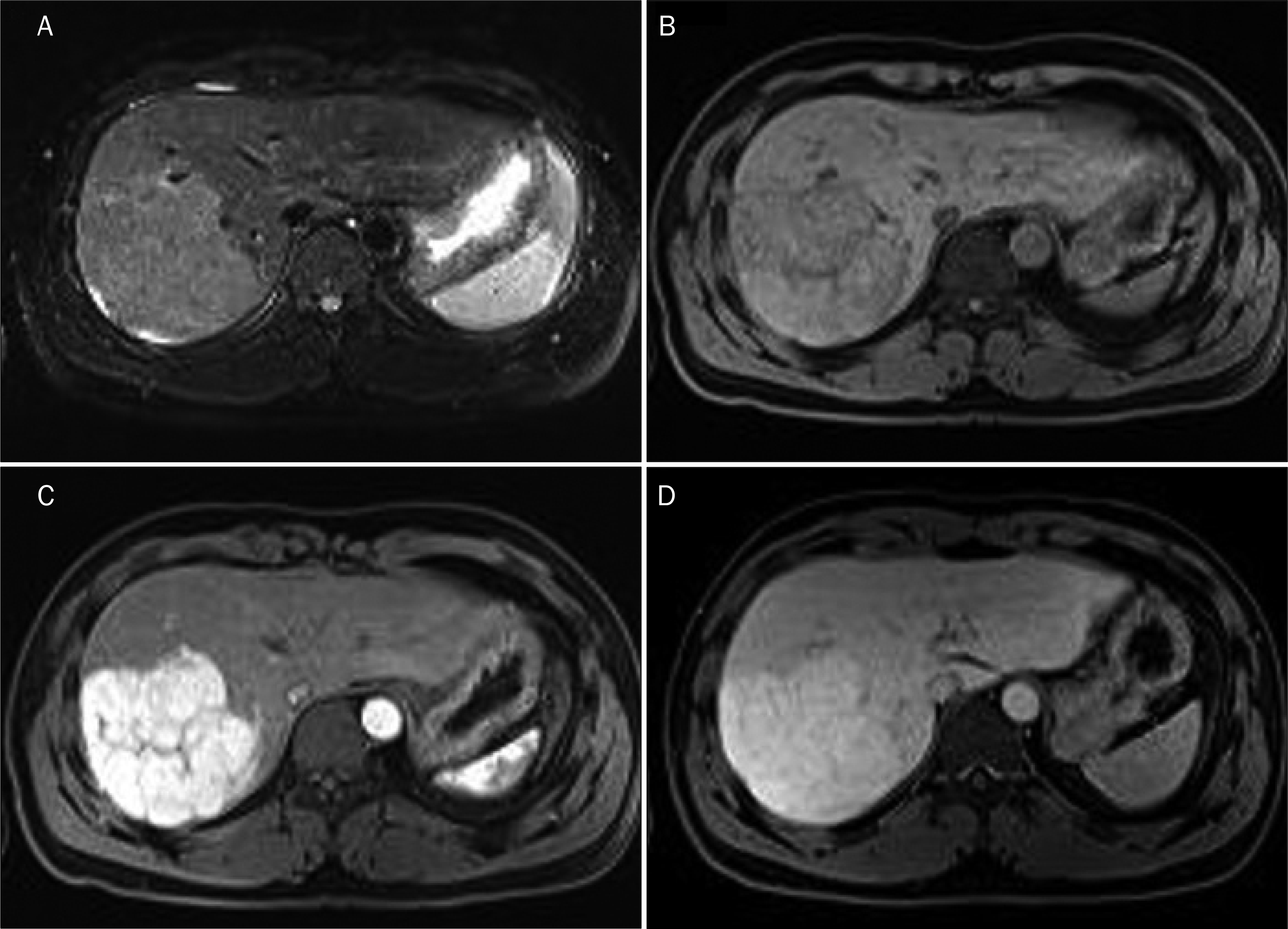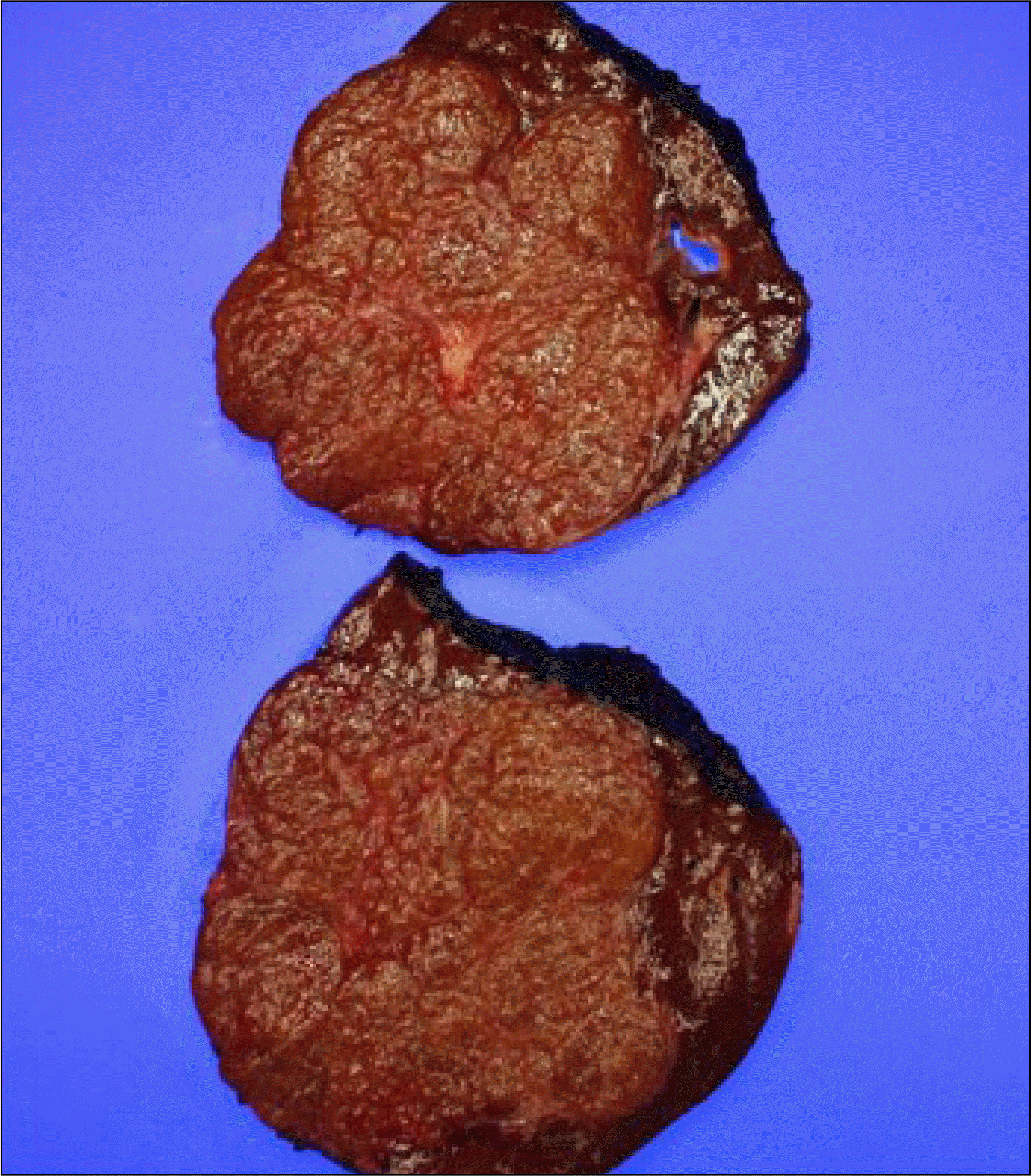References
1. Cristiano A, Dietrich A, Spina JC, Ardiles V, de Santibañes E. Focal nodular hyperplasia and hepatic adenoma: current diagnosis and management. Updates Surg. 2014; 66:9–21.

2. Carlson SK, Johnson CD, Bender CE, Welch TJ. CT of focal nodular hyperplasia of the liver. AJR Am J Roentgenol. 2000; 174:705–712.

3. Wanless IR, Mawdsley C, Adams R. On the pathogenesis of focal nodular hyperplasia of the liver. Hepatology. 1985; 5:1194–1200.

4. Vilgrain V, Uzan F, Brancatelli G, Federle MP, Zappa M, Menu Y. Prevalence of hepatic hemangioma in patients with focal nodular hyperplasia: MR imaging analysis. Radiology. 2003; 229:75–79.

5. Kang HY, La SS, Kong JH, et al. Clinical, radiological and pathological exploration of focal nodular hyperplasia of liver reported in Korea. Korean J Gastroenterol. 2008; 52:376–383.
6. Sato Y, Harada K, Ikeda H, et al. Hepatic stellate cells are activated around central scars of focal nodular hyperplasia of the liver–a potential mechanism of central scar formation. Hum Pathol. 2009; 40:181–188.

7. Nguyen BN, Flejou JF, Terris B, Belghiti J, Degott C. Focal nodular hyperplasia of the liver: a comprehensive pathologic study of 305 lesions and recognition of new histologic forms. Am J Surg Pathol. 1999; 23:1441–1454.
8. Shen YH, Fan J, Wu ZQ, et al. Focal nodular hyperplasia of the liver in 86 patients. Hepatobiliary Pancreat Dis Int. 2007; 6:52–57.
9. Procacci C, Fugazzola C, Cinquino M, et al. Contribution of CT to characterization of focal nodular hyperplasia of the liver. Gastrointest Radiol. 1992; 17:63–73.

10. Cherqui D, Rahmouni A, Charlotte F, et al. Management of focal nodular hyperplasia and hepatocellular adenoma in young women: a series of 41 patients with clinical, radiological, and pathological correlations. Hepatology. 1995; 22:1674–1681.

11. Quaia E. The real capabilities of contrast-enhanced ultrasound in the characterization of solid focal liver lesions. Eur Radiol. 2011; 21:457–462.

12. Bartolozzi C, Lencioni R, Paolicchi A, Moretti M, Armillotta N, Pinto F. Differentiation of hepatocellular adenoma and focal nodular hyperplasia of the liver: comparison of power doppler imaging and conventional color doppler sonography. Eur Radiol. 1997; 7:1410–1415.

13. Buetow PC, Pantongrag-Brown L, Buck JL, Ros PR, Goodman ZD. Focal nodular hyperplasia of the liver: radiologic-pathologic correlation. Radiographics. 1996; 16:369–388.

14. Irie H, Honda H, Kaneko K, et al. MR imaging of focal nodular hyperplasia of the liver: value of contrast-enhanced dynamic study. Radiat Med. 1997; 15:29–35.
Go to : 
 | Fig. 1.Liver dynamic CT showed a enhancing mass with a size of 10.4 cm at right lobe. (A) In the arterial phase, homogenous contrast enhancement with central scar low density was observed. (B) In the portal phase, the tumor was isodense, but central scar became hyperdense. CT, computed tomography. |
 | Fig. 2.Liver magnetic resonance image reveals a lobulated mass with a size of 10.4 cm. The mass shows slightly high signal with high signal central scar on the T2-weighted image (A), slightly low signal with low signal central scar on T1-weighted image (B), bright homogeneous enhancement at the arterial phase (C), slightly high signal with slightly high signal central scar on delayed phase (D). |
 | Fig. 3.After right posterior segmentectomy, specimen showed a large lesion of 10.4 cm is seen on the fresh cut section with a lobulated appearance and a stellate scar. |
 | Fig. 4.(A, B) Pathologic fingings show radiating bands that contain numerous vessels of variable sizes (A, H&E,×20; B, Masson Trichrome stain, ×200). (C) The tumor cells show neither structural nor cytological atypia. The tumor is interiorly divided by firous bands with inflammatoy infiltrates. A prominent artery shows thickened walls (H&E, ×200). |




 PDF
PDF ePub
ePub Citation
Citation Print
Print


 XML Download
XML Download